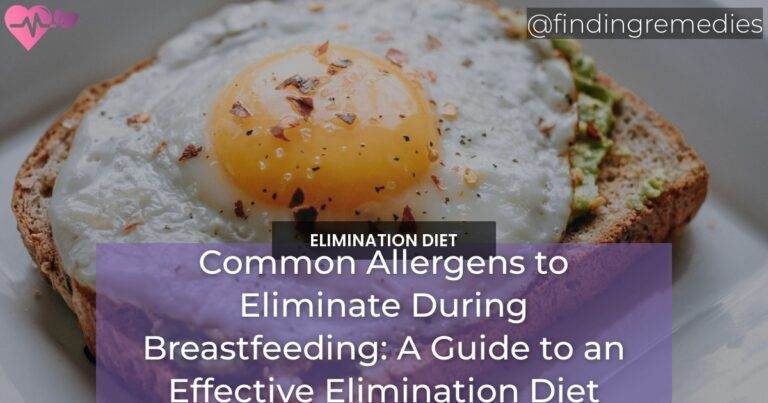As a breastfeeding mother, it’s important to watch what you eat because some foods can trigger allergies or intolerances in your baby.
In this article, we’ll discuss common allergens to eliminate during breastfeeding and how to follow an effective elimination diet.
Table of Contents
Allergies and Intolerances: Understanding the Basics
Allergies and intolerances are different but can have similar symptoms. Food allergies occur when your immune system overreacts to a particular food. Common food allergies include milk, egg, peanut, tree nuts, fish, and shellfish. Food intolerances, on the other hand, occur when your body has difficulty digesting or processing a particular food. Common food intolerances include lactose intolerance and gluten intolerance.
Elimination Diet: What is it and How Does it Work?
An elimination diet involves removing specific foods from your diet for a period of time and then gradually reintroducing them to determine which foods trigger symptoms in your baby. This process can take anywhere from a few weeks to a few months, depending on the severity of your baby’s symptoms.
What are some Common Foods to Eliminate during an Elimination Diet while Breastfeeding?
During an elimination diet, it’s important to eliminate specific foods that are known to trigger allergies or intolerances. Here are some common allergens to eliminate during breastfeeding:
What are some Common Allergens that are Eliminated in an Elimination Diet while Breastfeeding?
- Milk
- Eggs
- Peanuts
- Tree nuts (such as almonds, cashews, and walnuts)
- Fish
- Shellfish
- Soy
- Wheat
- Corn
- Gluten
ALSO READ
The Relationship between Breastfeeding and Allergies
Breastfeeding has been shown to help reduce the risk of allergies in babies. Breast milk contains antibodies that can help protect your baby from infections and illnesses. However, if your baby has an allergy, it’s important to identify and eliminate the trigger foods from your diet.
How to Determine if your Baby has Food Allergies or Intolerances?
It can be difficult to determine if your baby has a food allergy or intolerance because symptoms can vary widely. Common symptoms of food allergies or intolerances in babies include:
- Rashes or hives
- Eczema
- Crying or fussiness
- Vomiting or diarrhea
- Bloody stools
- Poor weight gain
If you suspect your baby has a food allergy or intolerance, it’s important to speak with your pediatrician for guidance.
What are the Benefits of an Elimination Diet While Breastfeeding for Both Mother and Baby?
An elimination diet while breastfeeding can have many benefits for both mother and baby, including:
- Reducing or eliminating symptoms of food allergies or intolerances in your baby
- Improving your baby’s digestion and overall health
- Reducing the risk of future allergies or intolerances in your baby
- Improving your own digestion and overall health
Tips for a Successful Elimination Diet While Breastfeeding
Here are some tips for a successful elimination diet while breastfeeding:
- Work with a registered dietitian or healthcare provider to create a safe and effective elimination diet plan
- Keep a food diary to help track your progress and symptoms
- Be patient and persistent, as it may take some time to identify trigger foods
- Stay hydrated and consume a variety of nutrient-dense foods
- Include foods that are rich in calcium and iron to ensure adequate intake
Foods to Include in an Elimination Diet While Breastfeeding
Here are some foods to include in an elimination diet while breastfeeding:
- Lean protein sources such as chicken, turkey, and fish
- Fruits and vegetables that are low in histamine, such as apples, blueberries, and spinach
- Grains that are gluten-free, such as rice, quinoa, and oats
- Healthy fats such as avocado, olive oil, and nuts (if not eliminating them)
- Calcium-rich foods such as kale, broccoli, and almonds
How Long Should you Follow an Elimination Diet While Breastfeeding?
The length of time you should follow an elimination diet while breastfeeding depends on your baby’s symptoms and how quickly they resolve. In some cases, it may take several weeks to notice a difference, while in others, symptoms may improve within a few days.
Challenges of an Elimination Diet While Breastfeeding
Eliminating specific foods from your diet while breastfeeding can be challenging, especially if you have a limited diet due to allergies or intolerances. It’s important to work with a healthcare provider or registered dietitian to ensure you’re getting adequate nutrients and to prevent nutrient deficiencies.
Foods to Avoid While Breastfeeding if Baby has Food Allergies or Intolerances
If your baby has a food allergy or intolerance, it’s important to avoid specific foods while breastfeeding. Here are some foods to avoid:
How to Read Food Labels for Hidden Allergens
- Milk and dairy products
- Eggs
- Peanuts
- Tree nuts (such as almonds, cashews, and walnuts)
- Fish
- Shellfish
- Soy
- Wheat
- Corn
- Gluten
It’s important to read food labels carefully to look for hidden sources of allergens, such as casein or whey (milk proteins), or soy lecithin (a common emulsifier made from soybeans).
Conclusion
An elimination diet while breastfeeding can be an effective way to identify and eliminate trigger foods that may be causing allergies or intolerances in your baby. With patience, persistence, and guidance from a healthcare provider or registered dietitian, you can successfully follow an elimination diet while still getting the nutrients you and your baby need.
RELATED ARTICLES:

